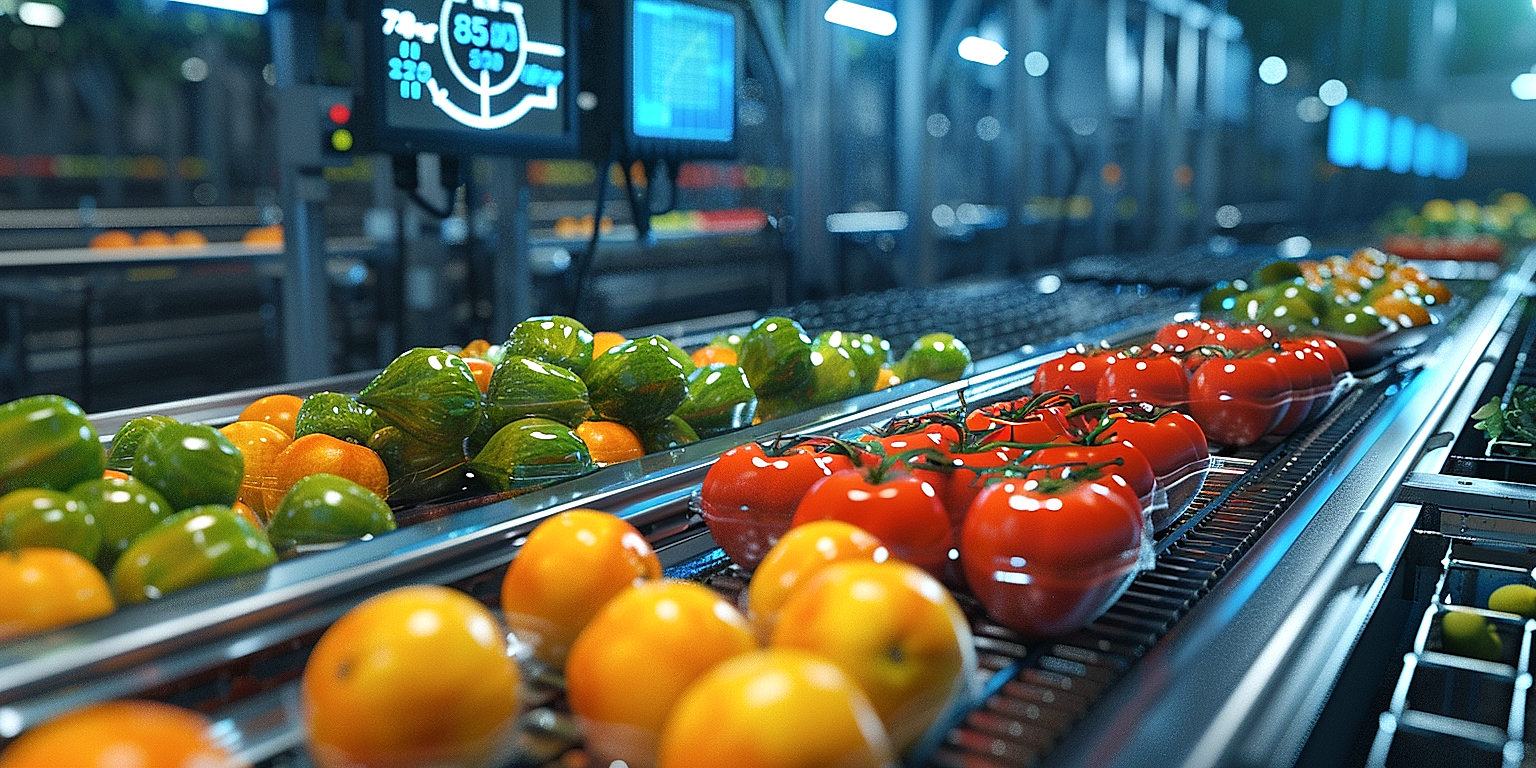The world of produce processing is often shrouded in mystery, leaving consumers and distributors alike seeking clarity.
The call for increased transparency in this industry stems from a need for trust and greater understanding about what exactly goes into bringing fruits and vegetables from farm to table.
This understanding can result in improved business practices and better consumer trust.
As stakeholders in this industry, we have a responsibility to respect and respond to this demand for openness.
This article aims to provide some helpful insights on the topic.
It builds on expert perspectives, industry case studies, and evidence-based strategies to promote transparency in the domain of produce processing.
Contents
- Insights For Enhancing Transparency In Produce Processing
- 1. Implement end-to-end tracing systems for produce
- 2. Mandatory Open Source Audits for Processing Units
- 3. Timely Public Disclosure of Inspection Results
- 4. Standardized Labeling about Origin and Treatment
- 5. Detailed Disclosure of All Used Additives.
- 6. Enhance stakeholder engagement in decision making
- 7. Prioritize transparent communication with consumers.
- 8. Utilize blockchain for supply chain transparency.
- 9. Regular Workforce Training about Transparency Importance
- 10. Share growth and harvesting practices openly.
- The Bottom Line
Insights For Enhancing Transparency In Produce Processing
1. Implement end-to-end tracing systems for produce
With the rapid increasing demand for transparency in produce processing, there is a rising need to implement end-to-end tracing systems for produce.
This comprehensive visibility enables not merely the identification of a product’s origin, but it goes further to provide details about its entire journey through the supply chain.
Through end-to-end tracing, consumers gain access to vital information about the produce they consume, such as the place and conditions of growing, harvesting techniques, the processing methods, and how it finally made its way to their plates.
This tracing system is pivotal in ensuring that any breaches of safety or health standards are quickly detected, traced, and rectified.
Moreover, these systems enhance the industry’s ability to conduct more effective, targeted recalls, dramatically minimizing potential risks to consumers.
As a result, producers who have implemented these systems demonstrate their commitment to ensuring consumer safety and, thus, win their trust.
As crucial as it is, implementing an end-to-end tracing systems is no easy feat – it requires a significant initial investment, an effective system design, and ongoing management.
Initial preparation incorporates the establishment of an efficient data collection system with the ability to track and document each step of the produce’s journey.
Data integrity is critical, ensuring the accuracy and reliability of the tracing system – the collected data must be protected against duplication, deletion, or alteration.
Consequently, there should be strict checks in place to verify the accuracy and completeness of captured data points.
Specifically, system curation is required at two levels – firstly, within each processing unit to track the produce’s journey, and secondly, at a systemic level to link the data across different functions in the supply chain.
The use of technologies like Radio Frequency Identification (RFID), QR Codes, and Blockchain can be adopted to efficiently track and authenticate products.
Key players within the supply chain must be adequately trained to operate these systems smoothly, adopt them in their daily operations, and respond effectively in case of a system error or failure.
Their understanding and acceptance of the end-to-end tracing promotes its success and the resultant benefits to consumers.
Additionally, regular system audits are necessary to ensure its smooth and efficient operation and to identify any gaps for improvement.
Lastly, it is crucial to ensure continuous communication with all stakeholders, specifically consumers, about how the system works and the information it provides, thus promoting transparency and trust.
In moving towards enhanced food transparency, the implementation of end-to-end tracing systems for produce ultimately offers an effective way to build trust with consumers and encourage their educated food choices.
2. Mandatory Open Source Audits for Processing Units
Mandatory open source audits for processing units play an integral part in enhancing transparency in produce processing.
Open source audits provide a detailed examination of the processing systems, thereby ensuring accountability in every production stage.
Given that these audits are open source, it ensures every stakeholder, including the consumers, has access to the full audit information.
Open source audits prove to be a catalyst for change and serve as a base for implementing any required improvements.
This measure ensures that processing units conform to the predefined industry standards and measures.
Even more, mandatory open source audits encourage honesty among producers by deterring malpractice and negligence.
The information obtained from the audits can be utilized to make informed decisions concerning production processes.
Performing regular open source audits allows for continuous monitoring and updating of the processing systems based on the recent audits’ findings.
Such disclosures help build consumer trust as they have proof of where their produce originates and how it is processed.
While the process of conducting open source audits may be expensive and time-consuming, the benefits reaped outweigh the cost.
Open source audits are also essential in detecting any ethical lapses early and thereby adopting corrective measures promptly.
Audits facilitate transparency between the producers, processors, distributors, and the end consumers.
Moreover, it enhances the credibility of the producers and reinforces brand reputation.
Open source audits, therefore, contribute towards achieving a transparent and efficient produce processing industry.
Ultimately, mandatory open source audits establish a culture of openness and accountability in produce processing.
3. Timely Public Disclosure of Inspection Results
One significant step towards enhancing transparency in the produce processing industry is the timely public disclosure of inspection results.
By publicly broadcasting these results, both consumers and other stakeholders can make informed decisions regarding which products to choose and endorse.
Such prompt disclosure ensures that any safety concerns or contamination issues are instantly brought to light.
Further, these public reports can act as a driving force that pressures processing units to follow the highest standards of food safety and cleanliness.
Indeed, the collective understanding and awareness brought about by the timely disclosure of inspection results can push the entire industry towards better compliance with regulations and an overall elevation in produce quality.
This strategy also allows for a smoother process of corrective actions to be initiated promptly and efficiently at any processing unit found deficient.
Achieving this level of transparency requires the collaboration of several key players in the industry, including regulatory bodies, processing units, and even consumers.
Regulatory bodies need to ensure inspections are thorough and results are published promptly and accurately.
Processing units, on the other hand, must show accountability, cooperating with regulators and willingly disclosing inspection results.
Lastly, customers can play a significant role by demanding transparency and holding companies accountable.
Furthermore, implementation of advanced technologies, such as Big Data and AI, can expedite the collection and analysis of data, making the disclosure of results even more timely and efficient.
Well-implemented, public inspection results can serve as a form of “open rating” system, providing a clear representation of a company’s commitment to high-quality and safe produce.
Overall, the timely public disclosure of inspection results stands as one of the cornerstones of transparency in the produce processing industry.
It effectively traces the journey of produce from the field to the consumer, while promoting a culture of responsibility and integrity within the industry.
By advancing into this direction, the industry not only meets today’s demand for information and transparency but also fosters greater trust between producers, consumers and all other stakeholders involved.
Moving forward, the focus should be on ensuring implementation and consistent adherence to this norm across the industry and on enhancing the efficiency, accuracy, and timeliness of these disclosures.
4. Standardized Labeling about Origin and Treatment
As conversations surrounding the transparency in food production continue to heighten, an important element up for discussion is the need to implement standardized labeling about origin and treatmentof produce.
In a generation where consumers are more interested in understanding where their food comes from and how it has been prepared, accurate labeling has become an indispensable tool within the produce processing industry.
The prominence of standardized labeling carries two-fold benefits, serving both the consumer and the producer.
From the consumer’s perspective, it’s not just about knowing what they are eating but also about trust and assurance in the brand they choose to patronize.
Standardized labeling about origin and treatment serves as an integrity check which leaves the consumer confident in their choices.
On the flip side, it offers producers the opportunity to showcase their ethical farming or manufacturing techniques and crucially, helps to distinguish their goods from other perhaps less transparent competitors in a crowded market.
The commitment to transparent labelling therefore, becomes a competitive advantage to businesses in the produce processing industry, helping foster and maintain consumer trust.
Most essentially, it is important to underline that standardized labeling is not just about the name of the product and where it was sourced.
It extends further to encompass information of how the product was grown, whether it’s organic or conventional, land use data, information about any treatments the product might have been exposed to during processing and a host of other important food safety parameters.
Standardized labels set a certain benchmark for the whole industry, ensuring that the information provided is uniform, easy-to-understand and verifiable.
A clear understanding of these labeling standards will also facilitate regulatory compliance, preventing unnecessary legal issues and sanctions.
Furthermore, standardized labeling can greatly contribute to the ongoing efforts towards sustainability within the food industry.
Food producers that meet certain environmental thresholds can include this information in their labels, incentivizing better industry-wide practices
.
Looking at the big picture, the role of standardized labeling in enhancing transparency in produce processing cannot be overemphasized.
This practice helps maintain an open dialogue between food producers and consumers, providing reassurance to the consumer about food safety and quality, while also ensuring a level playing field for producers.
This in turn, strengthens the relationship between the industry and its consumers, resulting into long-term business sustainability and growth.
5. Detailed Disclosure of All Used Additives.
The concept of detailed disclosure of all used additives in produce processing is a principle grounded in transparency and integrity.
This means that all the components that have been used in the processing procedure should be fully revealed to the public.
This not only includes the additives and chemicals that have been utilized but also the complete listing of ingredients involved.
Every single ingredient and additive utilized during the processing of produce should be made known to the public in the name of transparency.
This detailed disclosure allows consumers to make informed decisions about what they consume.
It is, however, important to note that disclosure should be comprehensive and user-friendly.
This means that whenever possible, technical terms should be replaced with easy to understand language, so even non-specialist consumers can understand.
Moreover, the potential effects of these additives, particularly in terms of health, should also be indicated, thereby reinforcing transparency with responsibility and care for consumers.
Transparency in this respect can also lead to consumer trust and brand loyalty.
In a world where consumers are becoming more conscious about what they consume, companies that fully disclose all used additives not only comply with regulation but also gain a competitive advantage.
For instance, a company that is open about its use of preservatives in its processed fruits may be trusted more by consumers, compared to a competitor who leaves the consumer guessing about the ingredients.
This transparency may instill a level of trust that keeps consumers coming back, thereby boosting the company’s bottom line.
In implementing a policy of detailed disclosure of all used additives, it is crucial that the approach is guided by ethical practices and stringent regulations.
Companies need to stay abreast of any changes in legislation regarding food safety and labelling, ensuring that their information disclosure is always compliant and up-to-date.
At the end of the day, the ultimate goal is to ensure the consumer’s right to know is satisfied, while also promoting a more transparent, honest, and accountable produce processing industry.
6. Enhance stakeholder engagement in decision making
Engaging stakeholders in decision-making processes in the produce processing business is an integral part of enhancing transparency.
Stakeholders, in this context, involve every individual or group directly or indirectly impacted by the organization’s operations ranging from farmers, suppliers, consumers, regulatory entities, employees to investors.
The benefits associated with increased stakeholder engagement are substantial and varied, contributing immensely to enhancing transparency in the supply chain.
Indeed, stakeholders vested in decision-making can put forth valuable insights, help bring about a deep understanding of the industry’s challenges, suggest potential solutions, and partake in shaping a more transparent, dependable, and sustainable supply chain.
Frequently, their collective knowledge and expertise can help in identifying overlooked elements or any form of operations that may compromise product transparency.
Engaging stakeholders in decision-making processes, therefore, offers a participatory platform promoting accountability and transparency in the supply chain transactions.
Consumer inclusion, particularly, builds trust as they get a chance to discern where their food comes from and how it is made, mitigating concerns about food safety, quality, or any unethical practices.
Similarly, farmers’ inclusion mitigates the obscurity between the farm and the processors, ensuring ethical and fair trade practices.
Regulators engaged in decision-making can strive for stronger enforcement of transparency and accountability rules in the processing industry.
Employee participation, on the other hand, encourages transparent internal communications inspiring a work culture that values transparency.
Columnal stakeholder engagement needs to be an ongoing process rather than a one-time activity.
This continuous dialogue equips the company to be proactive, adapt quickly to evolving needs and maintain a transparent transactional environment where every decision is communicated with clarity and rationale provided.
Therefore, for establishing transparency in produce processing, stakeholder engagement is non-negotiable which, when managed correctly, creates a win-win situation for all involved parties.
Every decision can signal the organization’s commitment to transparency, encouraging stakeholders to play their roles more responsibly.
This collective effort can cater to broader societal concerns creating a foundation of trust, accountability, and transparency essential for a sustainable produce processing industry.
Undeniably, increased stakeholder engagement facilitates transparency in produce processing, driving significant improvements towards a truly sustainable food system.
7. Prioritize transparent communication with consumers.
Transparency in consumer communication is an essential pillar in produce processing.
It acts as a bridge, conveying critical information about the purity, quality, and origin of the product from the producer to the consumer.
Keeping consumers well-informed strengthens the trust and bond between producers and consumers, ultimately leading to increased brand loyalty and customer satisfaction.
Prioritizing transparent communication cues consumers in on the integrity and responsibility of the producers and processors, thereby fostering unwavering confidence in their products.
Transparent communication not only concerns honest labeling and marketing of produce but also involves proactive sharing of information about the production process, ingredients used, additives, and handling methods.
This empowers consumers to make an informed choice, resulting in heightened customer satisfaction and improved brand value for the producers.
Moreover, clear, honest, and accessible communication helps engage customers directly, bridging gaps and improving mutual understanding.
This is especially effective in clearing any misconceptions, addressing grievances, or informing about any changes or issues in the product line.
Achieving transparency in communication also means proactively accepting and correcting product faults.
This shows the company’s commitment to value and quality, which in turn improves the overall perception and trustworthiness of the brand.
For instance, disclose any changes to product formulation, treatment, or even ownership responsibly and in a timely manner to the consumer.
Leverage the power of digital platforms like company websites, email newsletters, or social media channels to effectively communicate with customers, and ensure that the necessary information is readily available and easy to understand.
This type of transparency requires a commitment from the entire organization and its employees, from top-level management to the manufacturing and processing workforce.
Lastly, periodic training and awareness programs for staff can help them understand the importance of transparent communication, thereby strengthening the organizational culture around transparency.
It is crucial to remember that the concept of transparent communication extends beyond being legally compliant and is about sincerely engaging with the consumer and being open about the company’s practices.
8. Utilize blockchain for supply chain transparency.
The integration of blockchain technology in the supply chain management of the produce industry has immense potential for enhancing transparency.
Traditionally, supply chain tracking in the produce industry has been both expensive and time-consuming, leading to many issues related to transparency and trust between stakeholders.
Blockchain, with its decentralized and immutable nature, can serve as an effective solution to these transparency challenges.
The essence of blockchain is that the data stored within the system is immutable and transparent, making it near impossible for any actor within the supply chain to manipulate or misrepresent information without the knowledge of other participants.
The implementation of blockchain technology can provide a clear path of transactions that verifies the location, movement, and treatment of produce from farm to fork.
Not only does this boost the confidence of consumers in the authenticity of the products, but it also serves as an effective measure for preventing foodborne illnesses and ensuring that ethical and sustainable farming practices are upheld.
Further, blockchain technology can also be used in documenting and maintaining records of audits, inspections, and certifications of processing plants, thereby ensuring that the entire process is accountable and transparent.
This allows consumers and stakeholders alike to have real-time access to information about every stage of the processing, handling, and distribution of produce, instilling trust within the system.
The transparency that blockchain technology brings to the table shouldn’t be underestimated; it provides consumers, producers, and retailers alike with certainty and confidence in the produce they’re dealing with.
It is also worth mentioning that blockchain’s capacity to facilitate fast, secure, and transparent transactions can also lead to reduced costs and increased efficiencies, making it a win-win situation for all involved parties.
Moreover, this increased efficiency can translate into better pricing and product quality for end consumers.
An equally remarkable feature of the blockchain technology in the context of the produce industry is its potential to eliminate counterfeit products in the market.
By tracking and recording each transaction and movement, the likelihood of fraudulent activities and entry of counterfeit goods in the supply chain is massively reduced.
Certainly, the deployment of blockchain is not without its challenges, such as high upfront costs or the need for digital literacy among users.
However, its long-term benefits in fostering transparency, enhancing consumer trust, and promoting sustainability cannot be denied.
Summing up, adopting blockchain technology in the produce processing sector can be a significant step towards achieving the desired level of transparency.
9. Regular Workforce Training about Transparency Importance
One of the vital elements to enhancing transparency in produce processing is the implementation of regular workforce training.
This entails educating employees on the importance of transparency and arming them with strategies to attain it within their respective roles.
Through accurate and consistent education measures, a company can uphold a culture of full transparency, which is essential in securing and maintaining public trust.
Regular workforce training on transparency is an effective avenue for maintaining the credibility of a company and fostering consumer trust in today’s conscientious market.
These training sessions expose the staff to industry best practices regarding transparency, enabling them to provide clear information about the source and treatment of produce, usage of additives, and also overall growth and harvesting practices.
Scheduled training sessions can inspire employees to cultivate an environment or workspace that values transparency and openness.
Moreover, educating the workforce about the importance of maintaining transparency can promote ethical behavior in their interactions with suppliers, clients, and consumers.
Since transparency is not just about truth-telling but also about sharing pertinent information timely, staff should understand and be acquainted with the company’s disclosure policies.
This will ensure that they are aware of what needs to be disclosed, when it should be disclosed, and how to do so effectively.
During these training sessions, fostering a culture of open communication can be achieved by creating a ‘safe space’ where employees are encouraged to ask questions, disclose issues, and share experiences related to transparency.
An open, honest environment not only improves service delivery but also helps to maintain a positive company image in the eyes of consumers and other stakeholders.
Workforce training should be an ongoing process, with the importance of transparency being continuously highlighted and regularly implemented in the daily tasks of each employee to ensure sustained adherence to policies.
Lastly, it’s crucial for top management to attend these training sessions, as their presence not only symbolizes their acknowledgement and support of transparency but also helps to reinforce its value across all levels of the organization.
Regular workforce training is an effective strategy for strengthening the organization’s transparency infrastructure and promoting a culture of trust and accountability.
In an era where consumer awareness and demand for transparency in the food supply chain is on the rise, becoming open about the growth and harvest practices is a crucial step.
Giving an unadulterated insight into the cultivation conditions, use of chemicals, labour practices, and sustainability measures creates a bond of trust with the consumers.
Transparently sharing these practices also helps in achieving regulatory compliance and effective stakeholder communication.
By openly sharing growth and harvesting practices, businesses project a sense of accountability and responsibility towards their consumers and the environment.
Indulging in open dialogue about the produce’s lifecycle journey from seed to plate also empowers the consumers to make informed and conscious choices about what they eat.
Transparency in growth and harvesting practices also gives a competitive edge to businesses in a market that is becoming increasingly conscious about ethical and sustainable sourcing.
This visibility into the food cycle can increase consumer confidence and loyalty, leading to sustainable business growth.
Emerging technologies like blockchain and AI can aid in tracking and sharing the detailed journey of the produce.
On this digital platform, producers can upload real-time information about cultivation practices and harvesting techniques, which can be easily accessed by consumers.
This ensures the accuracy and authenticity of the information given to consumers, enhancing trust and loyalty.
By sharing honest information about environmental impact, carbon footprints, and sustainability measures, businesses can also connect with environmentally conscious consumers.
Moreover, transparency in growth and harvesting practices could potentially influence and shape industry standards and best practices.
Sharing such information also allows for collaborative problem-solving, learning, and innovation through feedback and stakeholder engagement.
Adopting an open policy about growth and harvesting practices is not just a moral obligation but also a strategic business move.
While this openness creates transparency in the supply chain, it also leads to a culture of honesty and integrity within the organization.
In-depth understanding about the connection between the farm, food, and people creates an empathetic and respectful food culture, benefiting everyone involved in the process.
The Bottom Line
Transparency in the agri-food sector is no longer a luxury but an imperative.
An end-to-end tracing system equips both producers and consumers with in-depth information about produce; mandatory audits ensure due diligence is followed at every processing stage.
Public disclosure of inspection results, detailed additives lists, and standardized labeling provide valuable insights while enhancing trust.
The engagement of stakeholders in decision-making processes, coupled with honest dialogues with consumers, creates a community-centered food system.
Innovative approaches like using blockchain technology can redefine supply chain transparency.
Additionally, regular training on transparency’s importance solidifies this culture.
An open sharing of growth and harvesting practices adds another dimension of frankness to this industry.
Therefore, it’s safe to argue adopting transparency mechanisms is a wise step toward a more sustainable and consumer-friendly agri-food industry.




